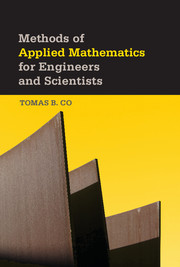Book contents
- Frontmatter
- Contents
- Preface
- I MATRIX THEORY
- III VECTORS AND TENSORS
- III ORDINARY DIFFERENTIAL EQUATIONS
- 6 Analytical Solutions of Ordinary Differential Equations
- 7 Numerical Solution of Initial and Boundary Value Problems
- 8 Qualitative Analysis of Ordinary Differential Equations
- 9 Series Solutions of Linear Ordinary Differential Equations
- IV PARTIAL DIFFERENTIAL EQUATIONS
- A Additional Details and Fortification for Chapter 1
- B Additional Details and Fortification for Chapter 2
- C Additional Details and Fortification for Chapter 3
- D Additional Details and Fortification for Chapter 4
- E Additional Details and Fortification for Chapter 5
- F Additional Details and Fortification for Chapter 6
- G Additional Details and Fortification for Chapter 7
- H Additional Details and Fortification for Chapter 8
- I Additional Details and Fortification for Chapter 9
- J Additional Details and Fortification for Chapter 10
- K Additional Details and Fortification for Chapter 11
- L Additional Details and Fortification for Chapter 12
- M Additional Details and Fortification for Chapter 13
- N Additional Details and Fortification for Chapter 14
- Bibliography
- Index
7 - Numerical Solution of Initial and Boundary Value Problems
from III - ORDINARY DIFFERENTIAL EQUATIONS
Published online by Cambridge University Press: 05 April 2013
- Frontmatter
- Contents
- Preface
- I MATRIX THEORY
- III VECTORS AND TENSORS
- III ORDINARY DIFFERENTIAL EQUATIONS
- 6 Analytical Solutions of Ordinary Differential Equations
- 7 Numerical Solution of Initial and Boundary Value Problems
- 8 Qualitative Analysis of Ordinary Differential Equations
- 9 Series Solutions of Linear Ordinary Differential Equations
- IV PARTIAL DIFFERENTIAL EQUATIONS
- A Additional Details and Fortification for Chapter 1
- B Additional Details and Fortification for Chapter 2
- C Additional Details and Fortification for Chapter 3
- D Additional Details and Fortification for Chapter 4
- E Additional Details and Fortification for Chapter 5
- F Additional Details and Fortification for Chapter 6
- G Additional Details and Fortification for Chapter 7
- H Additional Details and Fortification for Chapter 8
- I Additional Details and Fortification for Chapter 9
- J Additional Details and Fortification for Chapter 10
- K Additional Details and Fortification for Chapter 11
- L Additional Details and Fortification for Chapter 12
- M Additional Details and Fortification for Chapter 13
- N Additional Details and Fortification for Chapter 14
- Bibliography
- Index
Summary
In several cases, the analytical solution of ordinary differential equations, including high-order, multiple, and nonlinear types, may not be easy to obtain or evaluate. In some cases, it requires truncation of an infinite series, whereas in other cases, it may require numerical integration via quadratures.
An alternative approach is to determine the solution directly by numerical methods. This means that the solution to a differential equation will not be given as a function of the independent variables. Instead, the numerical solution is a set of points discretized over the chosen range of the independent variables. These points can then be plotted and processed further for subsequent analysis. Thus, unlike analytical solutions, numerical solutions do not yield compact formulas. Nonetheless, numerical methods are able to handle a much larger class of ordinary differential equations.
We begin the chapter with the problems in which all the fixed conditions are set at the initial point, for example, t = 0 or x = x0, depending on which the independent variable is. These problems are known as initial value problems, or IVP for short. We discuss some of the better known methods for solving initial value problems, such as the one-step methods (e.g., Euler methods and Runge-Kutta methods) and multistep methods (e.g., the Adams-Bashforth methods and Adams-Moulton methods).
Information
- Type
- Chapter
- Information
- Methods of Applied Mathematics for Engineers and Scientists , pp. 273 - 310Publisher: Cambridge University PressPrint publication year: 2013
Accessibility standard: Unknown
Why this information is here
This section outlines the accessibility features of this content - including support for screen readers, full keyboard navigation and high-contrast display options. This may not be relevant for you.Accessibility Information
- 1
- Cited by
